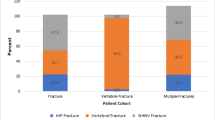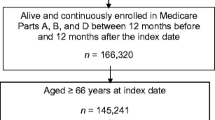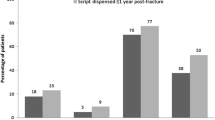Abstract
Background
Undertreatment of osteoporosis after hip or wrist fracture has been well documented, but the reasons for current patterns of care are poorly understood.
Objective
We tested the role of physician and patient characteristics in predicting undertreatment when osteoporosis management was clearly indicated after a hip or wrist fracture in women over age 65.
Methods
We assembled a cohort of 9,698 female Medicare beneficiaries aged ≥65 years who experienced hip or wrist fracture between 2000 and 2004 and their prescribing physicians.
Measurements
The dominant prescriber was identified as the physician prescribing at least 50% of patient prescriptions in the year after the fracture. Multivariate logistic regression estimated the role of physician and patient characteristics on osteoporosis management after hip or wrist fracture.
Results
Patients older than 90 and black patients were less likely to be treated for osteoporosis relative to patients aged 65–69 and white patients. Female providers were more likely to manage osteoporosis. Models including patient characteristics discriminated well between managed and unmanaged patients (C statistic 0.81), while adding physician predictors to the model provided no additional discriminatory ability (C statistic 0.81).
Conclusions
Our findings highlight that osteoporosis management rates are similar across providers, but vary considerably by patient types.

Similar content being viewed by others
References
Burge R, Dawson-Hughes B, Solomon DH, Wong JB, King A, Tosteson A. Incidence and economic burden of osteoporosis-related fractures in the United States, 2005 2025. J Bone Miner Res. 2007;22:465–75.
Solomon DH, Finkelstein JS, Katz JN, Mogun H, Avorn J. Underuse of osteoporosis medications in elderly patients with fractures. Am J Med. 2003;115:398–400.
Andrade SE, Majumdar SR, Chan KA, Buist SM, Go AS, Goodman M, et al. Low Frequency of Treatment of Osteoporosis Among Postmenopausal Women Following a Fracture. Arch Intern Med. 2003;163:2052–7.
Choudhry NK, Fletcher RH, Soumerai SB. Systematic review: the relationship between clinical experience and quality of health care. Ann Intern Med. 2005;142:260–W-30.
Kessler RC, Berglund P, Demler O, Jin R, Koretz D, Merikangas KR, et al. The epidemiology of major depressive disorder: results from the National Comorbidity Survey Replication (NCS-R). JAMA. 2003;289:3095–105.
Tu JV, Austin PC, Chan BTB. Relationship between annual volume of patients treated by admitting physician and mortality after acute myocardial infarction. JAMA. 2001;285:3116–22.
Epstein SA, Gonzales JJ, Weinfurt K, Boekeloo B, Yuan N, Chase G. Are psychiatrists’ characteristics related to how they care for depression in the medically Ill?: Results from a National Case-Vignette Survey. Psychosomatics. 2001;42:482–9.
Turchin A, Shubina M, Chodos AH, Einbinder JS, Pendergrass ML. Effect of board certification on antihypertensive treatment intensification in patients with diabetes mellitus. Circulation. 2008;117:623–8.
Solomon DH, Brookhart MA, Gandhi TK, Karson A, Gharib S, Orav EJ, et al. Adherence with osteoporosis practice guidelines: a multilevel analysis of patient, physician, and practice setting characteristics. Am J Med. 2004;117:919–24.
Cadarette Sea. Access to osteoporosis treatment is critically linked to access to dual-energy X-ray absorptiometry testing. Med Care. 2007;45:6.
Cadarette SMG, Monique AM, Jaglal SB, Beaton DB, Hawker GA. Access to osteoporosis treatment is critically linked to access to dual-energy X-Ray absorptiometry testing. Med Care. 2007;in press.
Ray WA, Griffin MR, Fought RL, Adams ML. Identification of fractures from computerized medicare files. J Clin Epidemiol. 1992;45:703–14.
Choudhry NK, Soumerai SB, Normand S-LT, Ross-Degnan D, Laupacis A, Anderson GM. Warfarin prescribing in atrial fibrillation: the impact of physician, patient, and hospital characteristics. Am J Med. 2006;119:607–15.
Raiford DS, Gutthann SP, Garcia Rodriguez LA. Positive predictive value of ICD-9 codes in the identification of cases of complicated peptic ulcer disease in the Saskatchewan Hospital Automated Database. [Article]. Epidemiology January 1996;7(1):101–104. 1996; 7: 101–04.
Piccola JE. Prescription drugs for senior citizens. Vol. 10/1/2007. State Senator Jeffrey Piccola, 15th District, PA.
Measuring Rurality. Washington DC: U.S. Department of Agriculture 2004.
Solomon DH, Schneeweiss S, Glynn RJ, Levin R, Avorn J. Determinants of selective cyclooxygenase-2 inhibitor prescribing: are patient or physician characteristics more important? Am J Med. 2003;115:715–20.
Hosmer DaSL. Applied logistic regression, 2nd edn. New York City: John Wiley and Sons; 2000.
Ko DT, Mamdani M, Alter DA. Lipid-lowering therapy with statins in high-risk elderly patients: the treatment-risk paradox. JAMA. 2004;291:1864–70.
Unequal Treatment: Confronting Racial and Ethnic Disparities in Health Care. Institute of Medicine 2002.
Solomon D, Polinski J, Stedman M, Truppo C, Breiner L, Egan C, et al. Improving care of patients at-risk for osteoporosis: a randomized controlled trial. J Gen Intern Med. 2007;22:362–7.
Solomon DH, Katz JN, Finkelstein JS, Polinski JM, Stedman M, Brookhart MA, et al. Osteoporosis improvement: a large-scale randomized controlled trial of patient and primary care physician education. J Bone Miner Res. 2007;22:1808–15.
Solomon DH, Morris C, Hailu C, Cabral D, Katz JN, Finkelstein JS, et al. Medication use patterns for osteoporosis: an assessment of guidelines, treatment rates, and quality improvement interventions. Mayo Clin Proc. 2005;80:194–202.
Macinko J SBaSL. Quantifying the health benefits of primary care phsycian supply in the United States. Int J Health Serv. 2007;37:16.
Starfield B, Shi L, Grover A, Macinko J. The effects of specialist supply on populations’ health: assessing the evidence. Health Aff. 2005: hlthaff.w5.97.
Chen JRS, Wang Y, Radford MJ, Krumholz HM. Physician board certification and the care and outcomes of elderly patients with acute myocardial infarction. J Gen Intern Med. 2006;21:7.
Epstein S. Update of current therapeutic options for the treatment of postmenopausal osteoporosis. Clinical Ther. 2006;28:151–73.
Acknowledgements
Funding
Dr. Solomon is supported by NIH R21 AG027066, NIH P60 AR047782, and Pfizer
Dr. Cadarette is supported by a Post-Doctoral Fellowship from the Canadian Institutes of Health Research.
Conflicts of Interest
None disclosed.
Author information
Authors and Affiliations
Corresponding author
Rights and permissions
About this article
Cite this article
Block, A.E., Solomon, D.H., Cadarette, S.M. et al. Patient and Physician Predictors of Post-Fracture Osteoporosis Management. J GEN INTERN MED 23, 1447–1451 (2008). https://doi.org/10.1007/s11606-008-0697-7
Received:
Revised:
Accepted:
Published:
Issue Date:
DOI: https://doi.org/10.1007/s11606-008-0697-7




